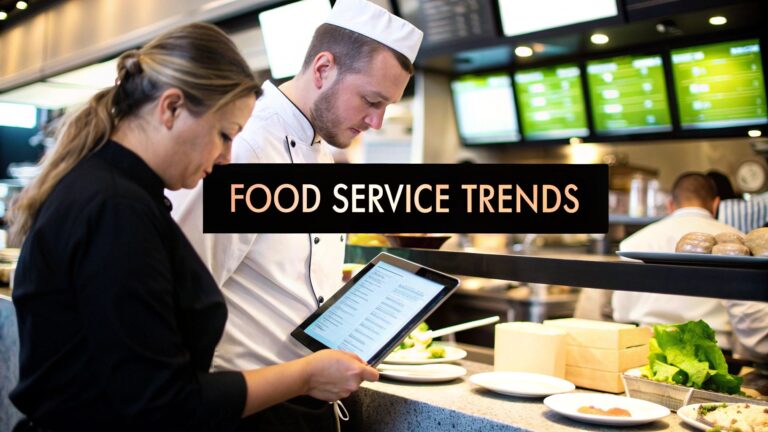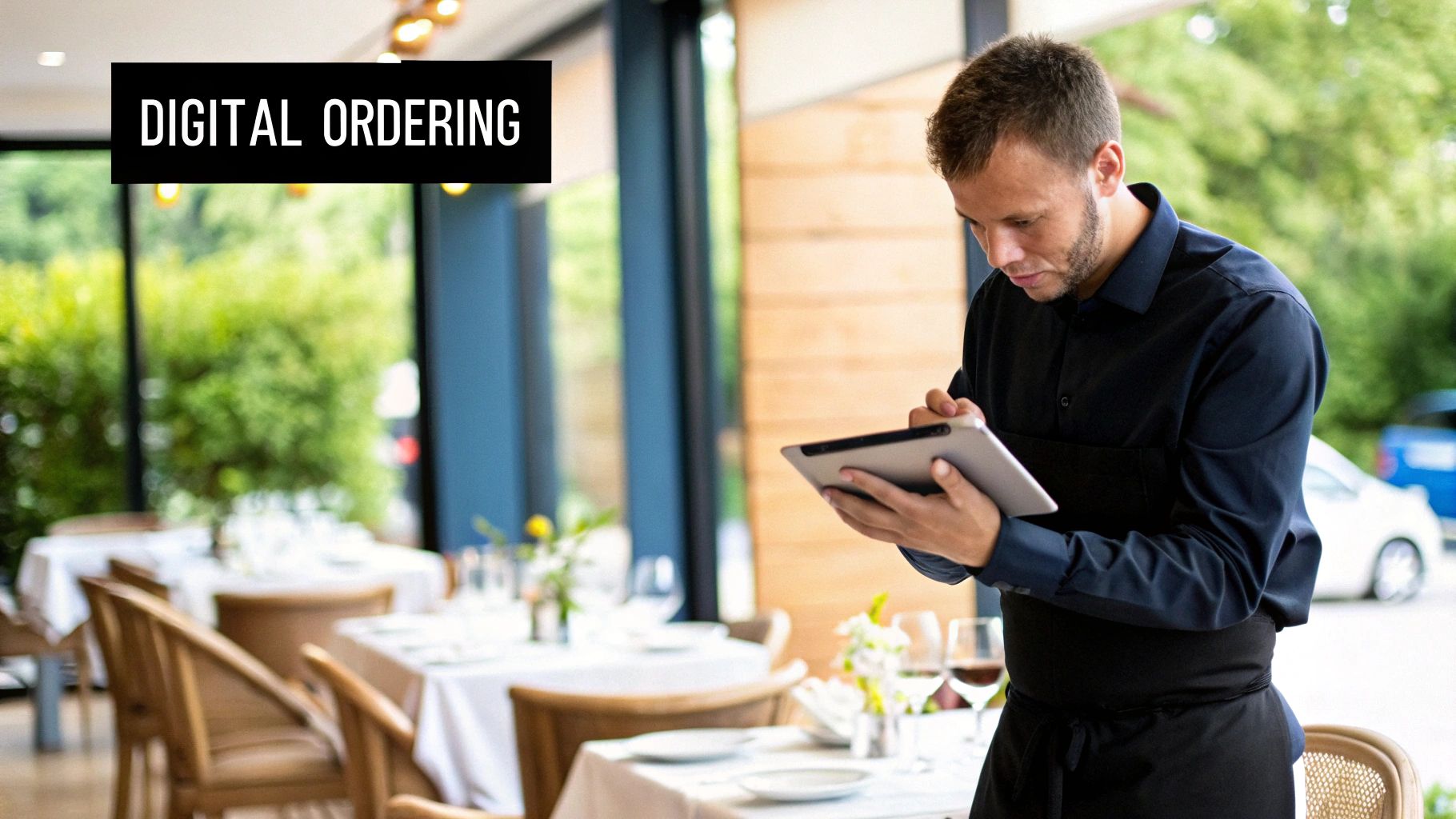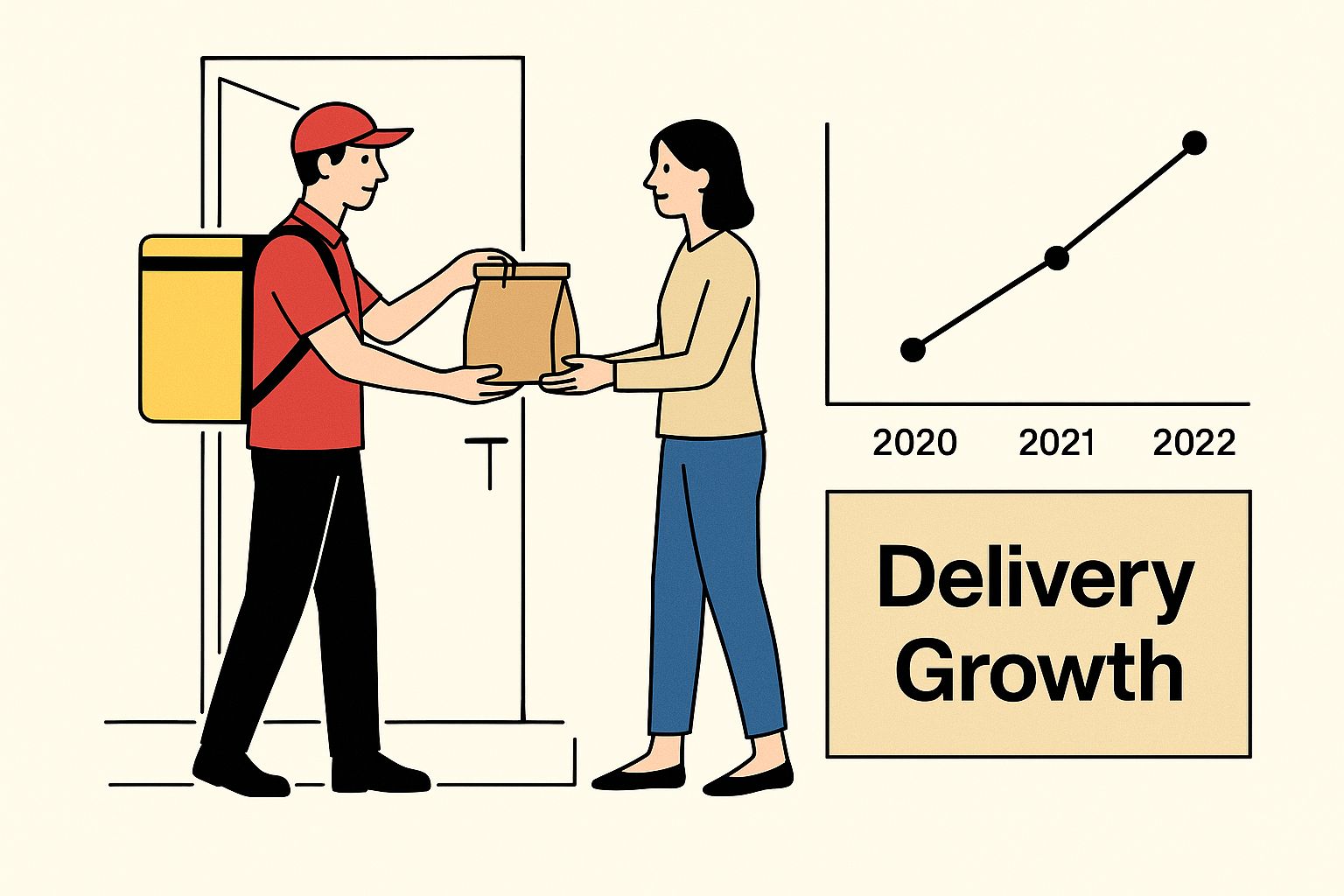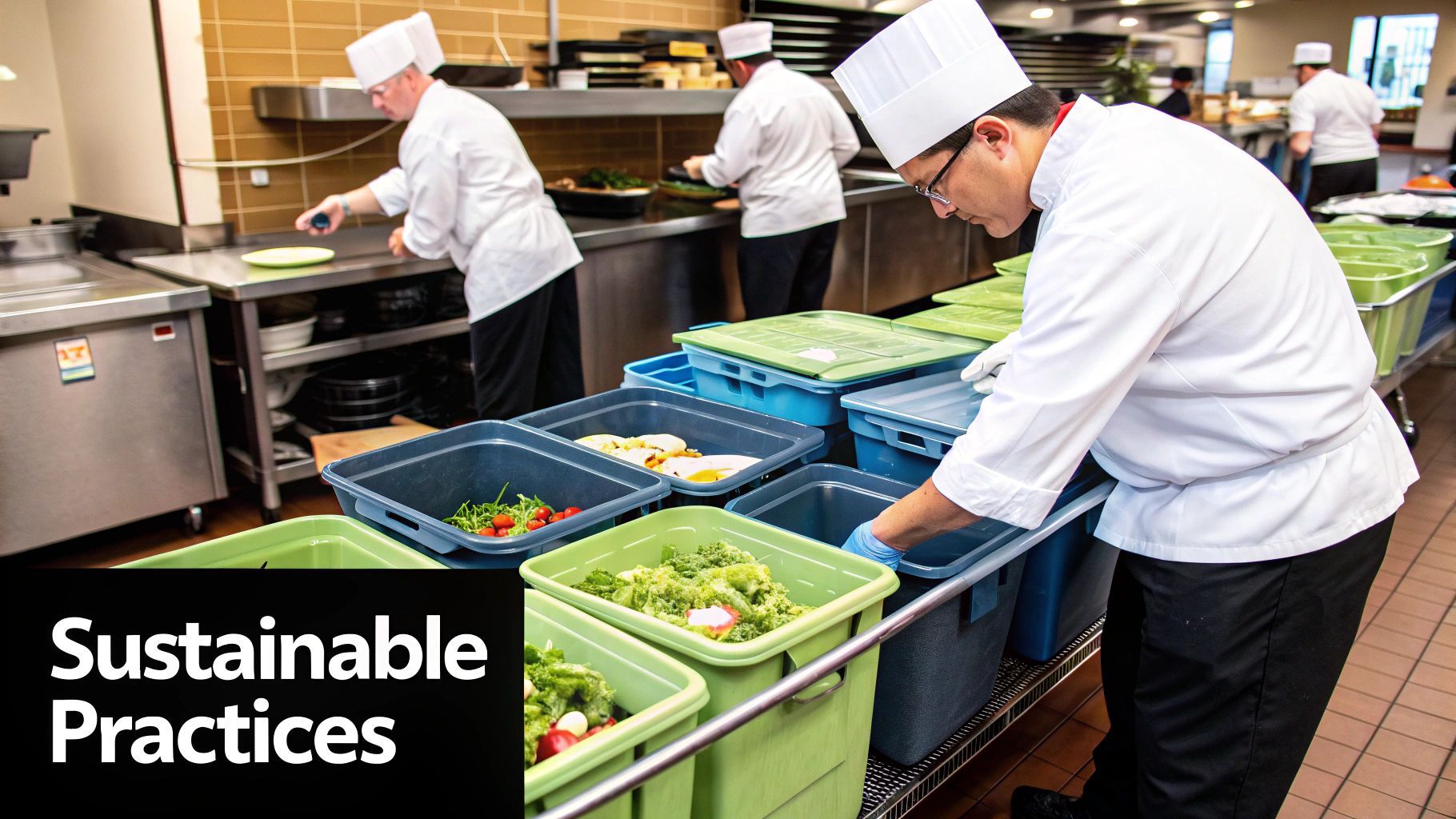Making Sense of Today’s Foodservice Landscape
The numbers swirling around the food service industry trends are huge, but what do they really mean for your restaurant on a Tuesday afternoon? It’s one thing to hear that the global market is growing, but it’s a totally different challenge to turn that broad trend into a tangible opportunity for your own kitchen. The reality is complicated: while the industry is expanding, profitability is still a tightrope walk for many operators.
Recent data shows the global foodservice market hit about $3.09 trillion in 2024 and is expected to climb past $4.1 trillion by 2033. This growth signals a strong recovery, with U.S. sales alone jumping 82% since 2020.
From Statistics to Strategy
So, how do you make sure your business gets a slice of that growing pie? The secret lies in understanding the difference between revenue and actual profit. While the top-performing restaurants might see profit margins around 10%, the industry average often lingers in a much tougher 3-5% range. This isn’t just about crunching numbers; it’s about making smart, strategic moves.
To put these numbers into perspective, let’s look at the key metrics shaping the industry’s future. The table below breaks down the projected growth in market size, employment, and profitability.
| Metric | 2023 | 2025 Projected | 2033 Projected |
|---|---|---|---|
| Market Size | $2.84 Trillion | $3.25 Trillion | $4.1 Trillion |
| Industry Employment | 15.5 Million | 16 Million | 17.5 Million |
| Average Profitability | 3-5% | 4-6% | 5-7% |
This data confirms that while sales are on the rise, the real work is in making that growth count on your bottom line.
As you can see, sales and employment are bouncing back, but the most successful establishments aren’t just passively riding this wave. They are proactively managing rising costs and operational pressures by asking some tough questions:
- Where are the hidden inefficiencies in our daily operations?
- How can we design our menu to be both popular with customers and profitable for us?
- Are we using technology effectively to cut costs without compromising the guest experience?
Answering these questions is your first step toward turning these huge industry shifts into profitable, practical strategies for your restaurant. It’s about finding your footing in this new environment and ensuring your growth is built to last.
Technology Solutions That Actually Work
Let’s cut through the tech hype and focus on what genuinely moves the needle in a restaurant. Smart automation isn’t about flashy robots; it’s about solving real-world problems like rising labor costs and evolving customer expectations. The right tech integrations can be a game-changer, but choosing wisely is key to seeing a return on investment instead of a new set of headaches.
Evaluating ROI Over Hype
Many restaurant owners get tripped up by investing in tech that doesn’t solve a core operational issue. Before committing, ask yourself: Does this tool reduce waste, speed up service, or free up my staff for more valuable customer interactions? The goal is to find solutions that directly address your biggest pain points.
Technology adoption has become a critical driver of change, particularly as the ongoing labor shortage pushes restaurants toward automation. Consider this: by 2025, digital ordering is expected to account for an estimated 70% of sales in some markets. That’s a massive jump from 40% in 2023. This shift helps offset rising labor costs, which have climbed from 30% of revenue to around 36%. Adopting tech is no longer a luxury but a necessity for staying competitive.
To put this into perspective, let’s look at how different technologies can impact key business metrics.
Inside Food Service Industry Trends: Technology That’s Changing the Game
| Technology Type | Labor Cost Impact | Customer Satisfaction | ROI Timeline |
|---|---|---|---|
| Integrated POS System | Reduced front-of-house labor by 10-15% due to streamlined order taking and payment processing. | Increased by 20% due to fewer order errors and faster service. | 6-9 Months |
| Kitchen Display System (KDS) | Decreased ticket times by an average of 2-4 minutes, allowing for higher table turnover. | Improved by 15% from more accurate and faster order fulfillment. | 9-12 Months |
| Automated Inventory Mgt. | Cut food waste costs by 5-8% by preventing over-ordering and tracking spoilage. | Maintained consistency as popular items were less likely to be out of stock. | 12-18 Months |
| Online Ordering Platform | Opened a new revenue stream, increasing overall sales by 25% without adding front-of-house staff. | Grew by 30% among takeout/delivery customers who value convenience. | 3-6 Months |
This data shows a clear pattern: targeted technology directly improves efficiency and the customer experience, leading to a measurable return. The key is to match the solution to a specific operational weakness.
The infographic below further illustrates the significant growth in delivery, a key area where technology plays a major role.
This visualization highlights how crucial a streamlined digital ordering and delivery system is for capturing a growing segment of the market.
Real-World Application and Results
The most successful tech implementations are seamless and solve problems without creating new ones. A great example is an integrated Point of Sale (POS) system that connects front-of-house orders directly to kitchen display systems and inventory management. This reduces errors, tracks stock in real-time, and provides valuable sales data.
Beyond operational technologies, effective digital marketing is critical. Businesses can boost reservations and foot traffic by implementing targeted and proven restaurant SEO strategies. Implementing these tools might seem daunting, but starting with a single, high-impact solution and building from there is a practical approach that minimizes disruption.
Sustainability That Drives Profits, Not Just PR
The big push for sustainability is more than just a passing trend; it’s a core expectation that’s changing how the food service industry operates. The great thing is, “going green” doesn’t have to hurt your wallet. In fact, many successful restaurant owners are finding that sustainable practices can actually boost their bottom line by cutting down on waste and building a loyal customer base. It all starts with a practical approach to where you get your ingredients and how you run your business.
Sourcing Smartly for Profit and Planet
Building relationships with local suppliers is a fantastic first move. While it might seem a bit pricier at first, it often results in fresher ingredients, lower transportation costs, and a compelling story that connects with your diners. Think about it: a farm-to-table pizzeria can easily charge more for a margherita pizza made with local heirloom tomatoes and fresh basil. This not only covers any extra cost but also attracts customers who value quality and community support.
You can start small:
- Connect with one or two local farms for your high-volume items, like seasonal vegetables or dairy.
- Create seasonal specials on your menu. This lets you use ingredients when they are at their freshest and most affordable, reducing your need for expensive, out-of-season produce.
- Showcase your partnerships on your menu and social media. Let customers see that you’re invested in supporting local producers.
More Than Just Food
Real sustainability goes beyond your shopping list. This is where running an efficient business and being environmentally responsible come together perfectly. Making simple changes, like switching to eco-friendly takeout containers, not only lessens your environmental impact but can also keep food tasting better on its way to the customer.
Performing a waste audit can be an eye-opener, revealing surprising ways to save money by reducing food spoilage and fine-tuning your orders. A complete approach to sustainability also considers a company’s operational footprint and its broader environmental, social, and governance (ESG) goals. For instance, being clear about your company’s long-term sustainability objectives is becoming essential for maintaining a strong brand reputation.
Capitalizing on Changing Consumer Spending Patterns
A fascinating shift is happening in the food service world. For the first time since the pandemic, people are spending more money at restaurants than they are on groceries. With foodservice now grabbing a huge 56.4% of the market, it’s clear that diners are craving experiences and convenience more than ever. This isn’t just a number to glance over; it’s a real change in how people are spending their money, offering a great opportunity for restaurant owners. The trick is to dig into what today’s customers really want and adjust your services to match.
Adapting to New Dining Priorities
So, what does this shift actually mean for your restaurant? It’s about more than just the food on the plate. It’s about building a complete experience, whether someone is dining in your establishment or getting their meal to go. Customers are signaling they’re ready to pay for things they value, which looks different for various groups.
- Convenience Seekers: This group is all about easy online ordering and delivery that is both quick and dependable. They want a frictionless process from start to finish.
- Experience Chasers: These diners are looking for a unique atmosphere, top-notch service, and a meal that feels special—like a real event.
- Value Hunters: They’re on the lookout for family meal deals, loyalty points, and menu items that strike a balance between high quality and affordability.
As the image shows, this trend affects everyone, from a quick-service spot to a high-end restaurant. Every type of operation needs to think about how it can cater to these new spending habits. For many, that means getting their off-premises game right. If you’re looking for practical tips on this, a great place to start is figuring out the best packaging. Making sure your service style aligns with what your customers are looking for is the best way to tap into this renewed spending.
Menu Innovation That Drives Revenue
Your menu is far more than a list of what’s available; it’s one of the most powerful sales tools you have. This is where sustainability and profitability truly meet. The most successful restaurants are mastering menu innovation, creating dishes that both delight customers and protect their bottom line. This isn’t just about throwing a trendy ingredient on a plate. It’s about designing a menu that fits your brand identity and what your kitchen can realistically handle.
Finding that sweet spot between industry trends and operational reality is what turns a short-lived gimmick into a dependable revenue source.
Balancing Trends with Practicality
A well-crafted menu tells a story and feels authentic to your brand. Imagine a local café introducing a line of “newstalgia” treats, like a gourmet take on a classic childhood cereal bar. This taps into customer nostalgia using high-margin ingredients, creating something fresh without needing a massive operational change.
Here are a few practical ways to get creative with your offerings:
- Introduce LTOs: Limited-Time Offers are fantastic for creating a sense of urgency and testing new ideas without full commitment. You could try a seasonal root vegetable hash for brunch or feature a unique mushroom-based burger for a month to see how your regulars respond.
- Deconstruct Entrees: Try offering main proteins and sides separately. This gives customers more control over their meal and their spending. Someone on a budget might be more inclined to order a la carte than to skip an entree entirely because of the price.
- Focus on Texture: Sometimes, the smallest change makes the biggest impact. Adding elements like a crunchy chili crisp to a dish or a velvety cold foam to a drink costs very little but creates a premium experience that customers are happy to pay more for.
Using Data to Refine Your Offerings
While creativity is key, your decisions should be backed by solid data. This is where menu engineering comes in. It’s the process of analyzing your menu’s profitability and popularity to make smarter, more strategic choices about what you offer.
This classic analysis grid helps you see your menu in a new light. It can reveal that a popular dish (Plowhorse) is actually hurting your margins and needs a price bump, or that a high-profit item (Puzzle) just needs a little more promotion to become a customer favorite. By understanding this data, you can make targeted adjustments that directly boost your revenue.
Strategic Infrastructure Investment Opportunities
The restaurant construction market is slated to become a $378.27 billion industry by 2029, and it’s tempting to jump on the growth bandwagon. But experienced owners know that just building more isn’t the answer. The real win is in making smart infrastructure choices that reflect today’s food service industry trends, making your operations smoother and keeping customers happy.
Before you even think about signing a lease for a new spot or knocking down walls in your current one, take a hard look at what your guests actually want. It’s less about cramming in as many tables as possible and more about creating a versatile space that offers a genuine experience.
Optimizing Your Physical Space
Modern restaurant design has to be adaptable. Imagine creating different “zones” inside your restaurant. You could have a quiet, intimate corner for date nights, a lively bar area with high-top tables, and a comfortable section for families. This kind of thoughtful layout broadens your appeal and can serve different customer moods all under one roof.
This image captures the delicate balance between a restaurant’s vibe and its practical function. See how the lighting, seating, and decor all come together to create a specific atmosphere? Your own investment should strive for that same harmony, where every choice you make supports both your brand and how your team works.
Smart Investments for Modern Operations
Looking past the decor, your infrastructure upgrades should tackle real-world operational challenges. With takeout and delivery continuing to drive a huge chunk of revenue, having a well-thought-out area for off-premise orders is no longer a luxury—it’s essential.
- Dedicated Pickup Zones: Don’t let delivery drivers and takeout customers crowd your host stand. A separate, clearly signed area prevents bottlenecks and keeps your dining room from feeling chaotic.
- Enhanced Kitchen Flow: Your kitchen layout might be perfect for dine-in service, but can it handle a rush of online orders? Consider reorganizing the line to support a high volume of to-go tickets without slowing down service for seated guests.
- Packaging Stations: Give your staff the space and tools they need to assemble orders quickly and correctly. This includes having the right disposable food containers ready to go, which is key for making sure food stays hot and fresh on its way to the customer.
Key Takeaways for Foodservice Success
Keeping up with the food service industry trends isn’t just about knowing the latest trends; it’s about putting them into practice in your daily operations. Your path forward rests on three key areas: smart technology use, genuine sustainability, and a solid grasp of what your customers want. Don’t feel like you have to do everything at once. A better approach is to pick the changes that will make the biggest difference for your specific business.
Start by identifying your single biggest headache. Is it soaring labor costs? Mounting food waste? Or maybe you’re struggling to bring in new faces? Your answer to that question will tell you exactly where to begin.
Your Action Plan
For many restaurant owners, the best place to start is by improving the customer experience from the moment they walk in. A huge part of this is making sure your staff is top-notch. Investing in effective hospitality customer service training can transform a decent meal into an unforgettable one, which is what builds loyalty and brings people back.
Next, it’s time to take a hard look at your menu and how you run things behind the scenes. Give yourself some concrete goals:
- Benchmark Progress: Challenge yourself to cut food waste by 5% in the next three months. You can achieve this by implementing a more precise inventory tracking system.
- Warning Signs: Are your utility bills creeping up every month? That’s a clear signal to start researching more energy-efficient kitchen equipment.
- Milestone Goals: Plan to introduce a limited-time offer (LTO) that features a local supplier within the next quarter. It’s a great way to test the waters of sustainable sourcing and see how your customers respond.
This image shows just how broad the food service industry trends worldwide are, from cozy cafes to massive catering companies. The core principles of success, however, are the same no matter your size. The goal is always to focus on profitable and sustainable growth.
Ready to perfect your packaging and elevate your customers’ takeout experience? Explore our extensive collection of high-quality, reliable packaging solutions at MrTakeOutBags.com and find the perfect fit for your business today.







Comments are closed.